Effect of the Location of Fault Fracture Zones on the Stability of Symmetrical Submarine Tunnels
Abstract
:1. Introduction
2. Engineering Geological Characteristics
3. Analysis of the Influence of the Fault Fracture Zone on the Lining Structure of Submarine Tunnels
3.1. Analysis of the Influence of Water Blocking and Drainage Restriction on the Displacement of Submarine Tunnel Lining Structures Affected by Fault
3.2. Analysis of the Effect of Water Blocking and Drainage Restriction on the Internal Force of the Lining Structure of a Submarine Tunnel Affected by Faults
4. Analysis of the Influence of the Fault Fracture Zone on the Stability of the Surrounding Rock around a Submarine Tunnel
4.1. Analysis of the Influence of the Fault Fracture Zone on the Displacement of Surrounding Rock
4.2. Analysis of the Influence of the Fault Fracture Zone on the Plastic Zone
5. Conclusions
Author Contributions
Funding
Acknowledgments
Conflicts of Interest
References
- Ai, Q. Overview of Underwater Highway Tunnels and Related Technical Issues. Traffic Constr. Manag. 2007, 1, 46–49. [Google Scholar]
- Xu, B.; Li, S.; Li, S.; Zhang, Q. The Relationship between Seepage Volume and Rock Cover Thickness in Subsea Tunnel. Mech. Eng. 2007, 1, 34–37. [Google Scholar]
- Zhou, Y.; Chen, W.; Li, S. Research on Rock Cover Thickness of Submarine Highway tunnel. J. Rock Mech. Eng. 2004, S2, 4704–4708. [Google Scholar]
- Qing, S.; Xie, W.; Gu, W.; Huang, S. Innovation of Key Construction Technology for Kiaochow Bay Submarine Tunnel with Boring and Blast Method. J. Railw. Eng. 2011, 28, 63–69. [Google Scholar]
- Li, P.; Zhang, D.; Wang, M.; Fang, Q.; Li, B. Mechanical Properties of Lining Structure and Its Cross Section Shape Optimization of Subsea Tunnel. China Railw. Sci. 2009, 30, 51–56. [Google Scholar]
- Zhang, P. Model Test Research on the Distribution law of Water Pressure Upon Lining and the stress Characteristics of Lining Structure in Subject to Subsea Tunnel. Master’s Thesis, Beijing Jiaotong University, Beijing, China, 2008. Available online: https://kns.cnki.net/kcms/detail/detail.aspx?dbcode=CMFD&dbname=CMFD2008&filename=2008049740.nh&v=qOIUypyORwBjpg%25mmd2FLSnIdPVU9987KOTqFWh%25mmd2BWFP%25mmd2BH6Eetq9icTTALFBuFW%25mmd2FpU5sMz (accessed on 8 May 2021).
- Li, S.; Song, S.; Li, L.; Zhang, Q.; Wang, K.; Zhou, Y.; Zhang, Q.; Wang, Q. Decelopement on Subsea Tunnel Model Test System for Solid-Fluid Coupling and its Application. J. Rock Mech. Eng. 2013, 32, 883–890. [Google Scholar]
- Wu, J. Research on The Distribution Law of Seepage Field and The Water Pressure Characteristics of Lining Structure in Subject to Underwater Tunnel of weak Surrounding. Master’s Thesis, Beijing Jiaotong University, Beijing, China, 2013. [Google Scholar]
- Wang, X.; Tan, Z. Study on the Characteristics of Water Pressure on the Composite Lining in Underwater Tunnels. Mod. Tunn. Technol. 2015, 52, 89–97. [Google Scholar]
- Wang, Z.; Wang, J.; Zheng, Y.; Zhang, L. Analysis on Stability of Subsea Tunnel in Fault-rupture Zone. Tunn. Constr. 2007, S2, 60–63. [Google Scholar]
- Wang, Q. Formulation and Verification of Grouting Reinforcement Ring for Fault Fracture Zone of Qingdao Subsea Tunnel. Road Traffic Technol. 2018, 34, 165–170. [Google Scholar]
- Qiao, J.; Chen, X.; Li, R. Grouting Waterproof Construction Scheme for Submarine Tunnel through Fault Fracture Zone. Sichuan Cem. 2017, 5, 29, 96. [Google Scholar]
- Noii, N.; Khodadadiana, A.; Wick, T. Bayesian Inversion for Anisotropic Hydraulic Phase-Field Fracture. arXiv 2020, arXiv:2007.16038. [Google Scholar]
- Khodadadian, A.; Noii, N.; Parvizi, M.; Abbaszadeh, M.; Wick, T.; Heitzinger, C. A Bayesian estimation method for variational phase-field fracture problems. Comput. Mechan. 2020, 66, 827–849. [Google Scholar] [CrossRef] [PubMed]
- Wang, J.; Zheng, Y.; Bao, L. Analysis of Seepage Stability of Submarine Tunnels under Localized Fracture Zone Conditions. Tunn. Constr. 2011, 31, 457–462. [Google Scholar]
- Wang, L.; Li, T. Stability Analysis of Pre-grouting Reinforcement of Submarine Tunnel through Fault Fracture Zone. J. Zhengzhou Univ. 2010, 31, 73–77. [Google Scholar]
- Ye, Z.; Zhang, C. Influence of Loose Contact between Tunnel Lining and Surrounding Rock on the Safety of the Tunnel Structure. Symmetry 2020, 12, 1733. [Google Scholar] [CrossRef]
- Zhou, S.; Pan, G.; Luo, X. Assessment on Construction Risks of Sub-sea Tunnels Crossing Fault and Fracture Zones and Countermeasures. Tunn. Constr. 2010, 30, 360–364. [Google Scholar]
- Wang, Z.; Wang, J.; Zheng, Y.; Zhang, L. Limit Analysis of Subsea Tunnel Stability by Finite Element Method in Fault-Rupture Zone with Water Penetration. J. Rock Mech. Eng. 2007, S2, 3751–3755. [Google Scholar]
- Su, J.; Jie, Y.; Niu, X.; Liu, C.; Liu, X. Mechanical Behavior of Tunnel Lining with Cracks at Different Positions. Symmetry 2020, 12, 194. [Google Scholar] [CrossRef] [Green Version]
- Li, G.; Wang, C.; Wang, G.; Xiao, Z.; Wu, X.; Jiang, F. Effect of the Blocking Water and Limiting Discharge and Surrounding Rock Permeability on the Stability of Subsea Tunnel. Geotech. Geol. Eng. 2021, 39, 1365–1380. [Google Scholar] [CrossRef]

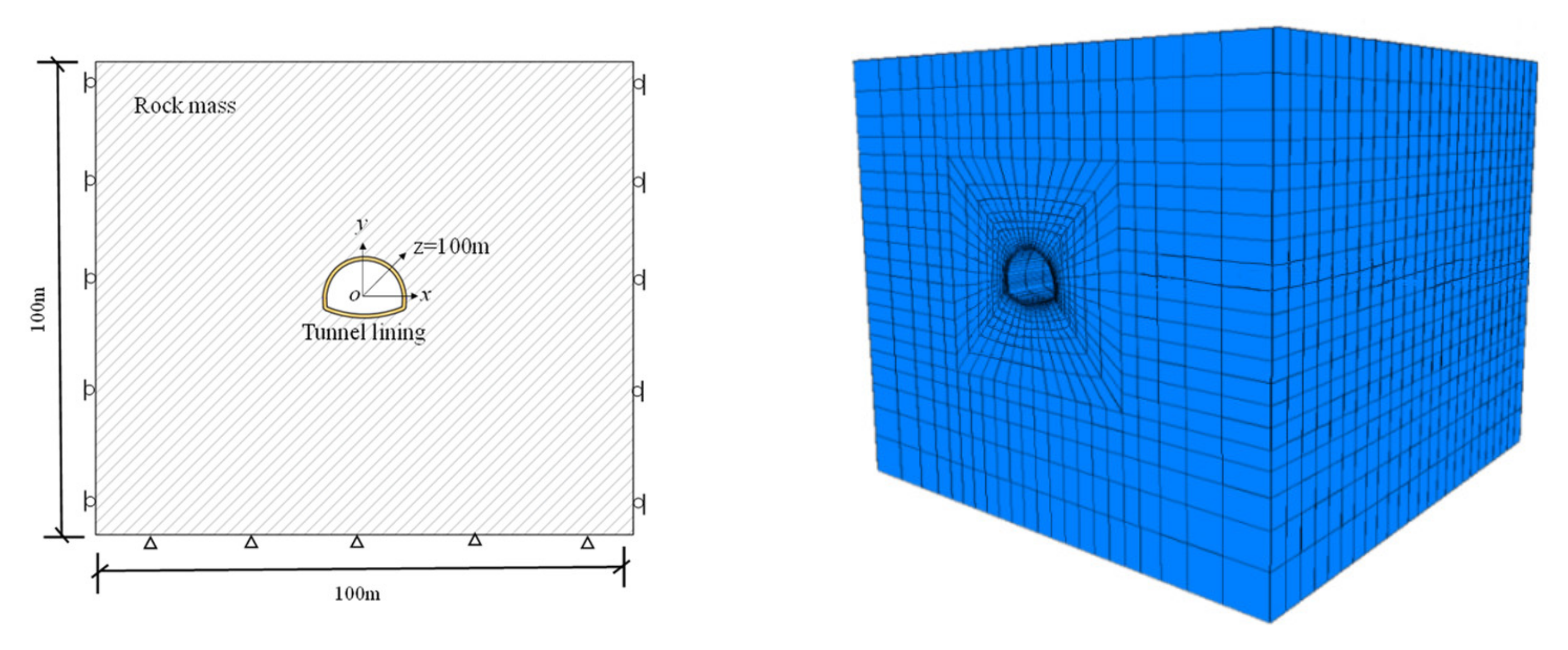
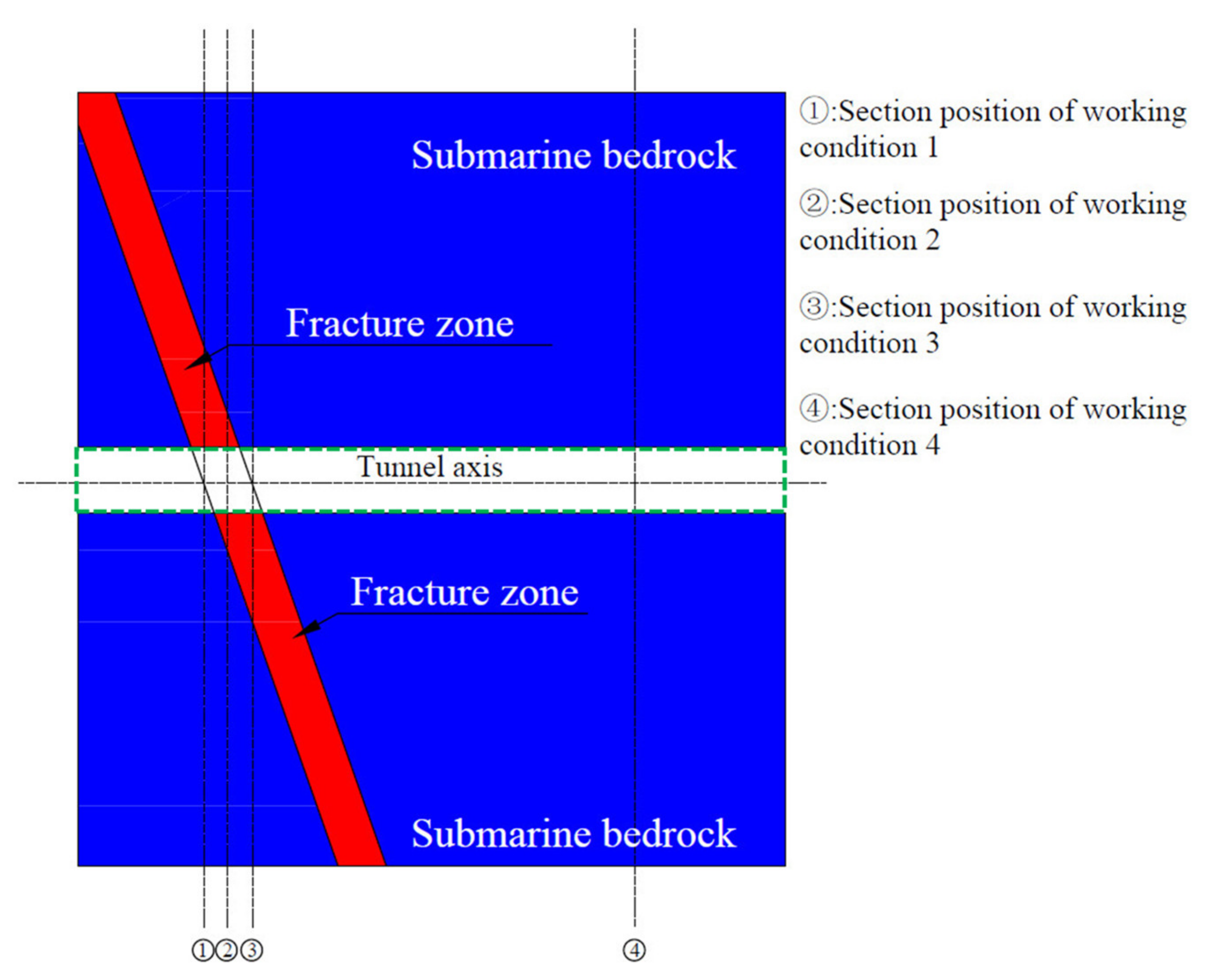
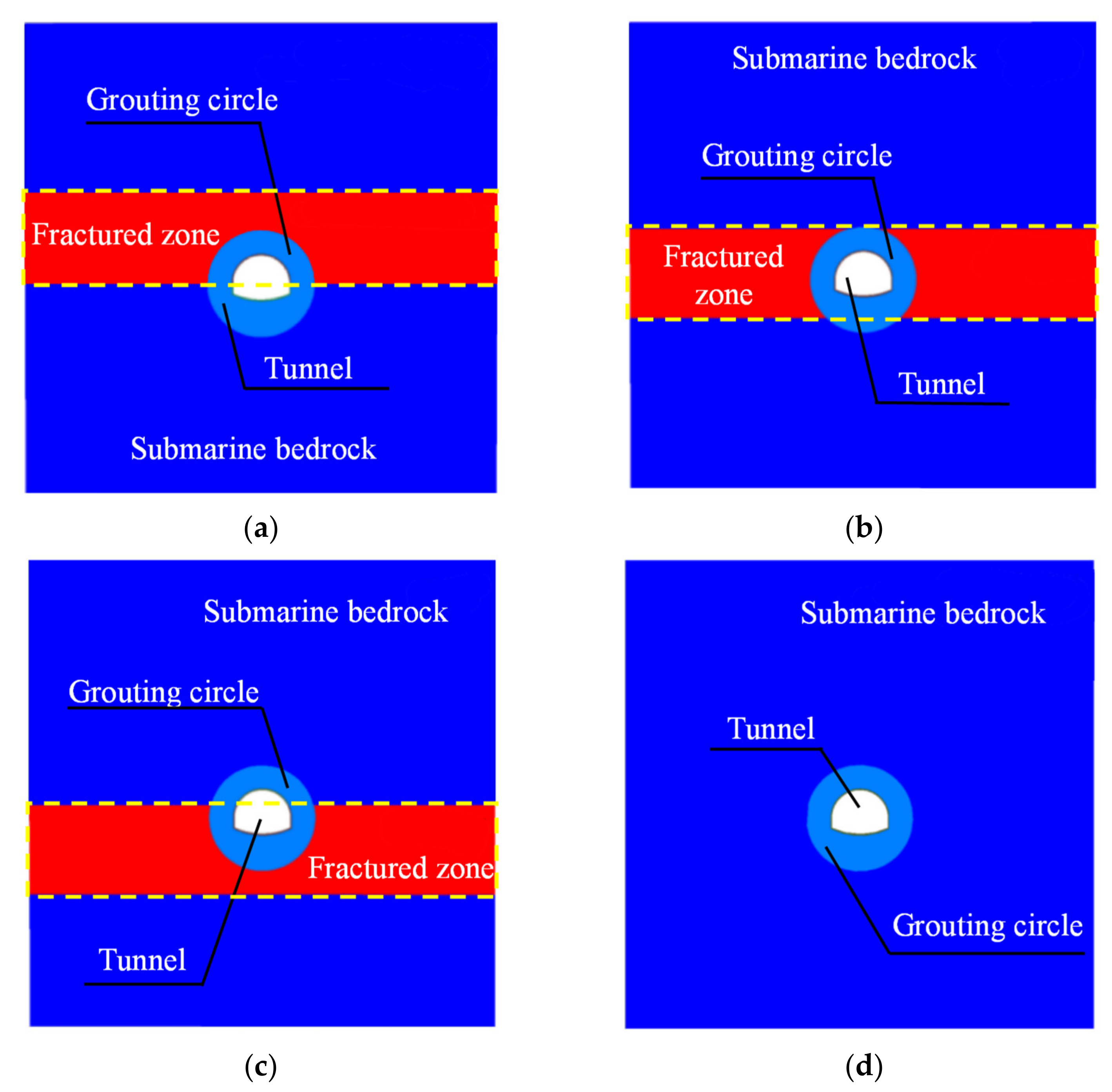

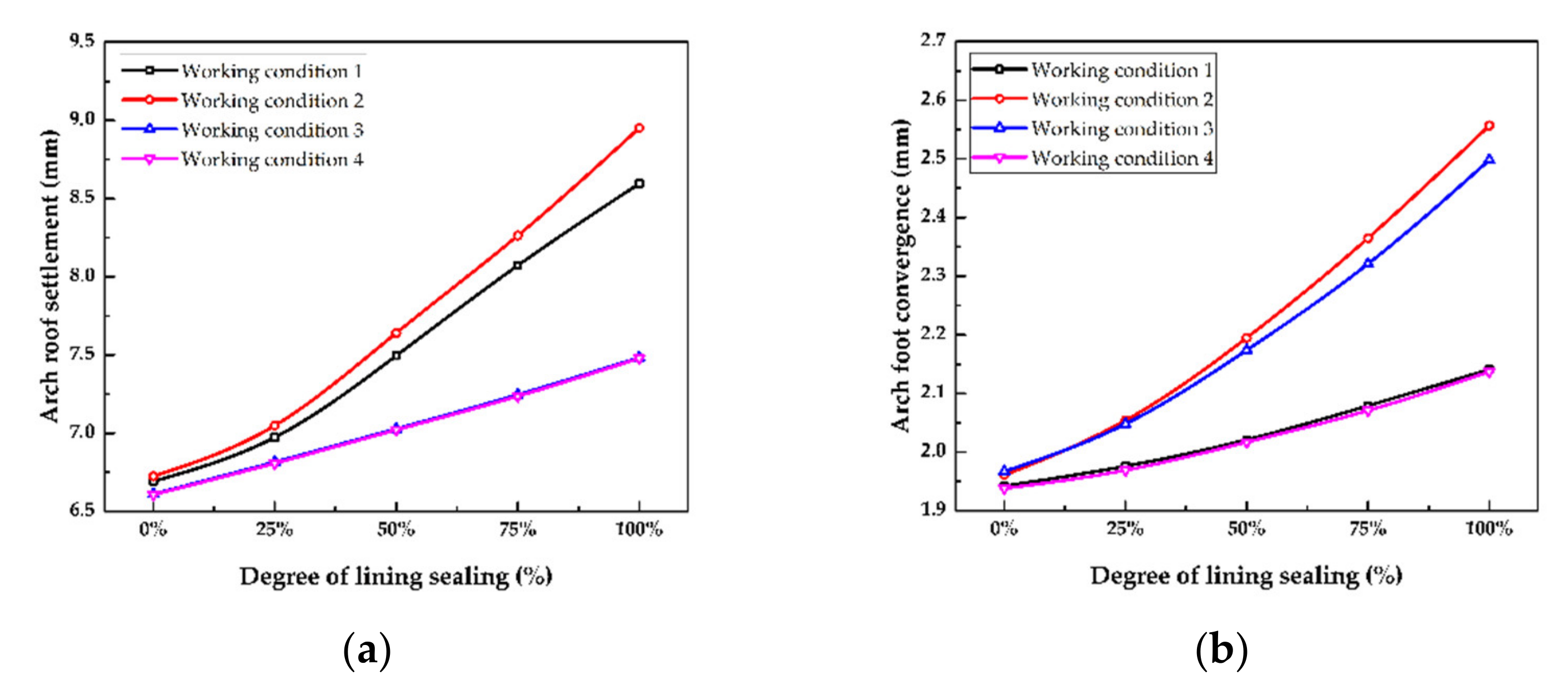

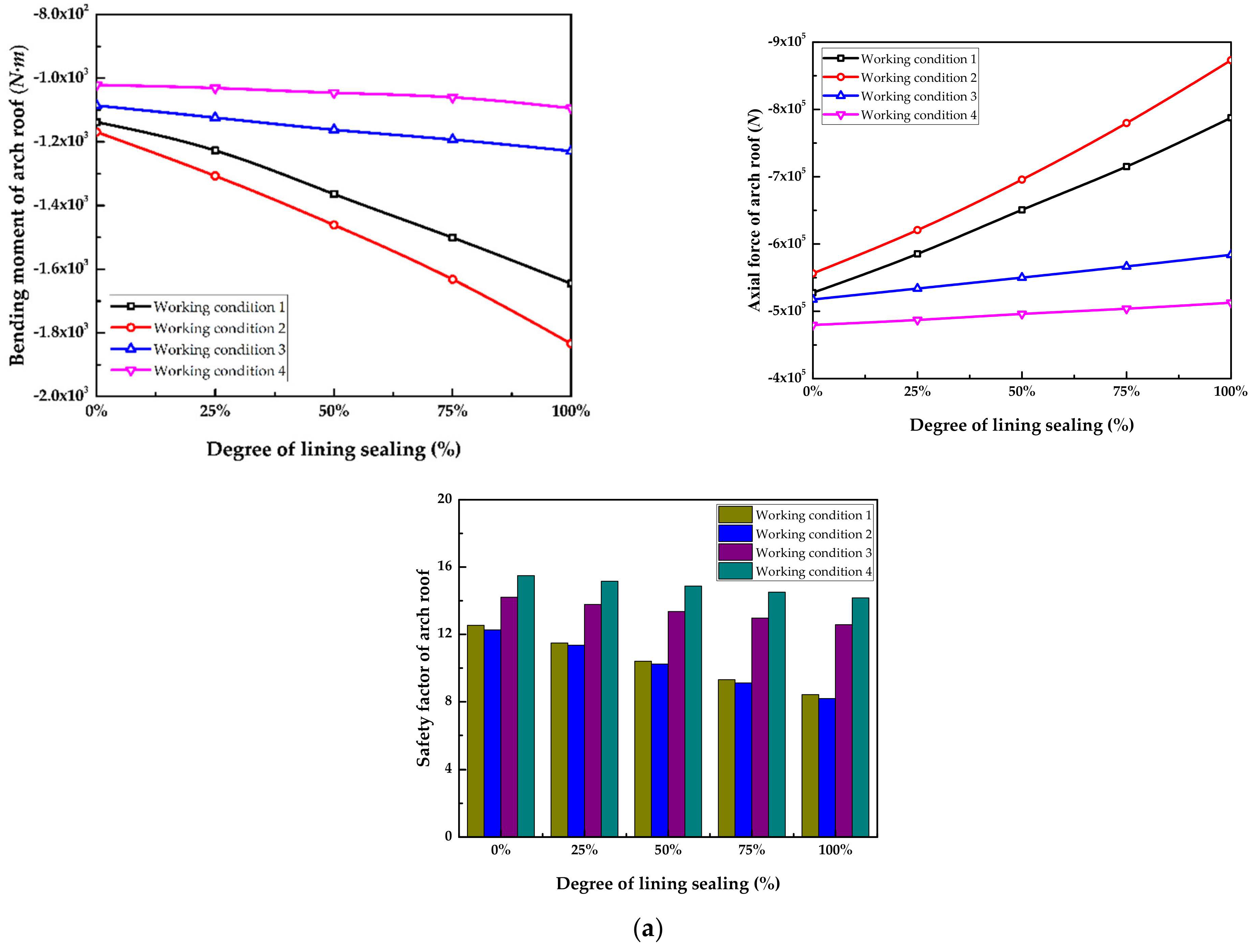
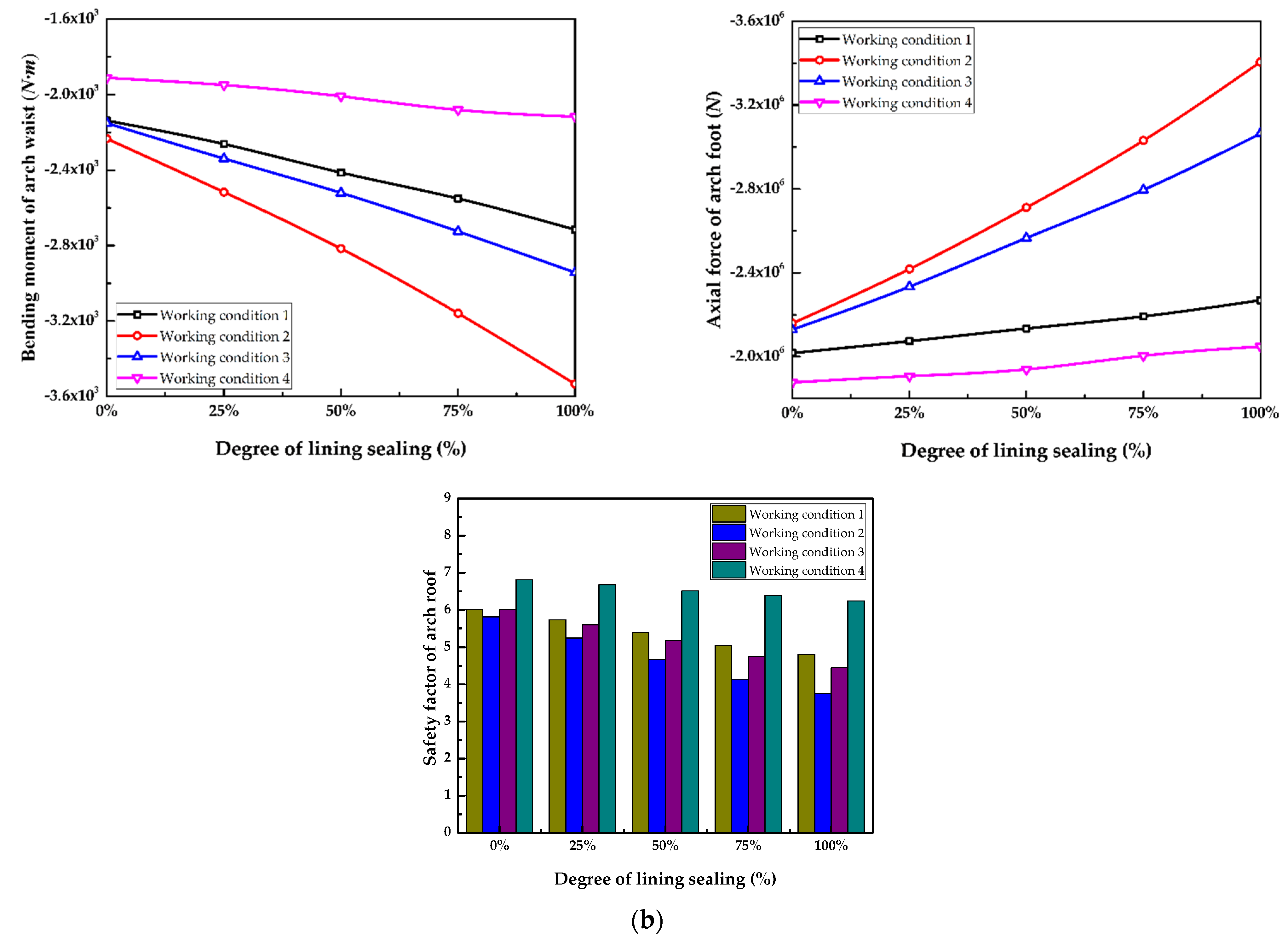
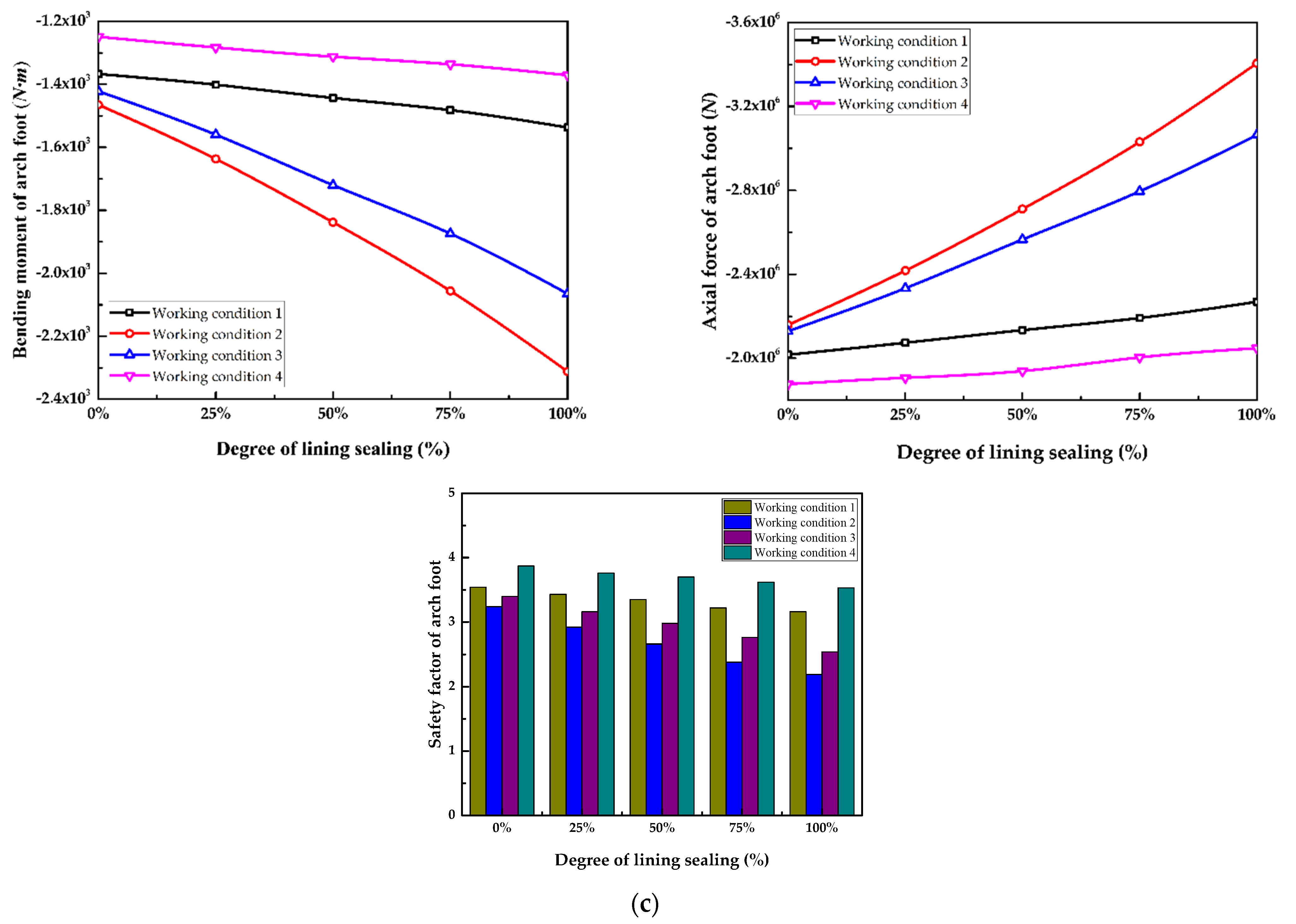
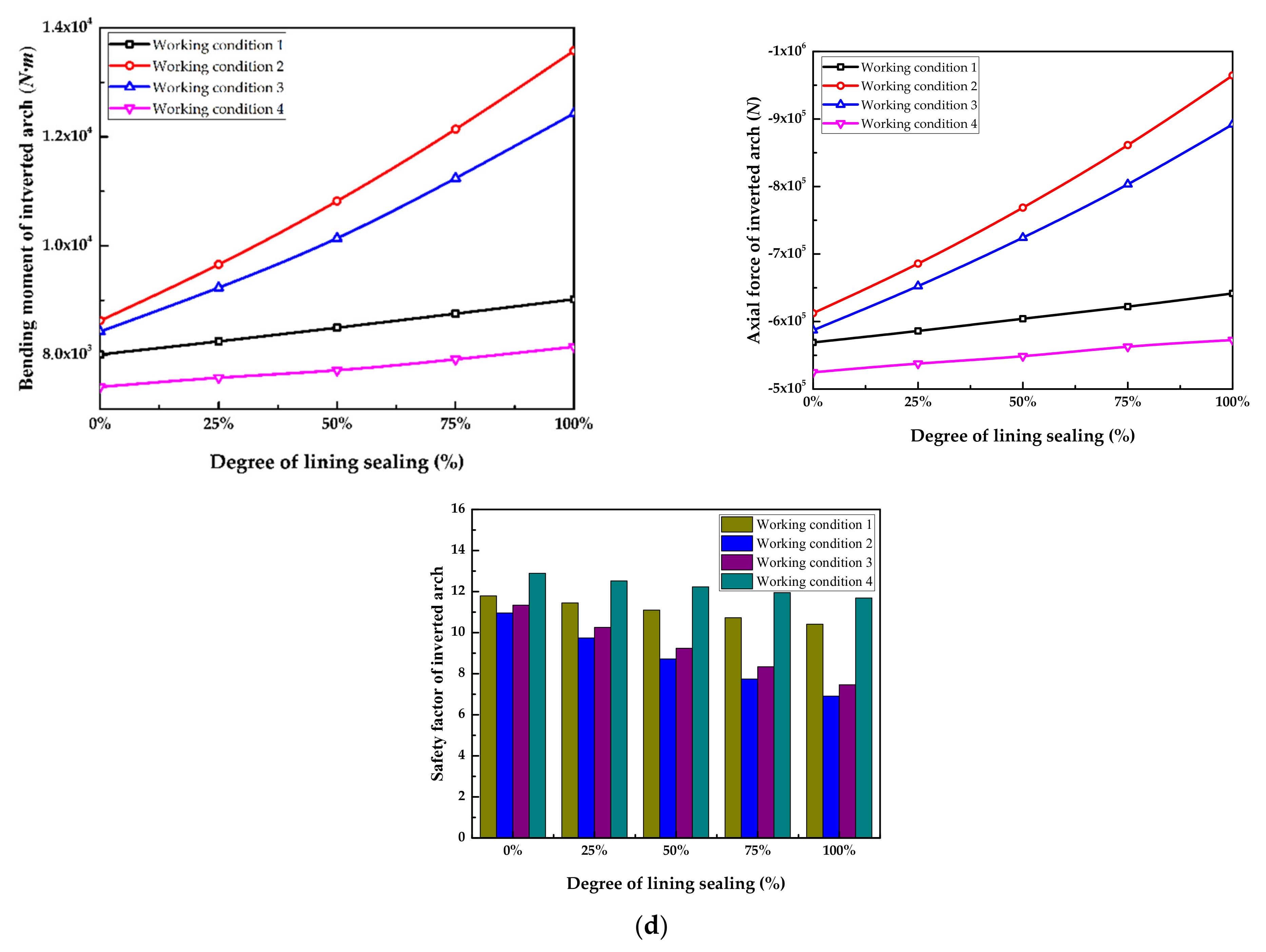
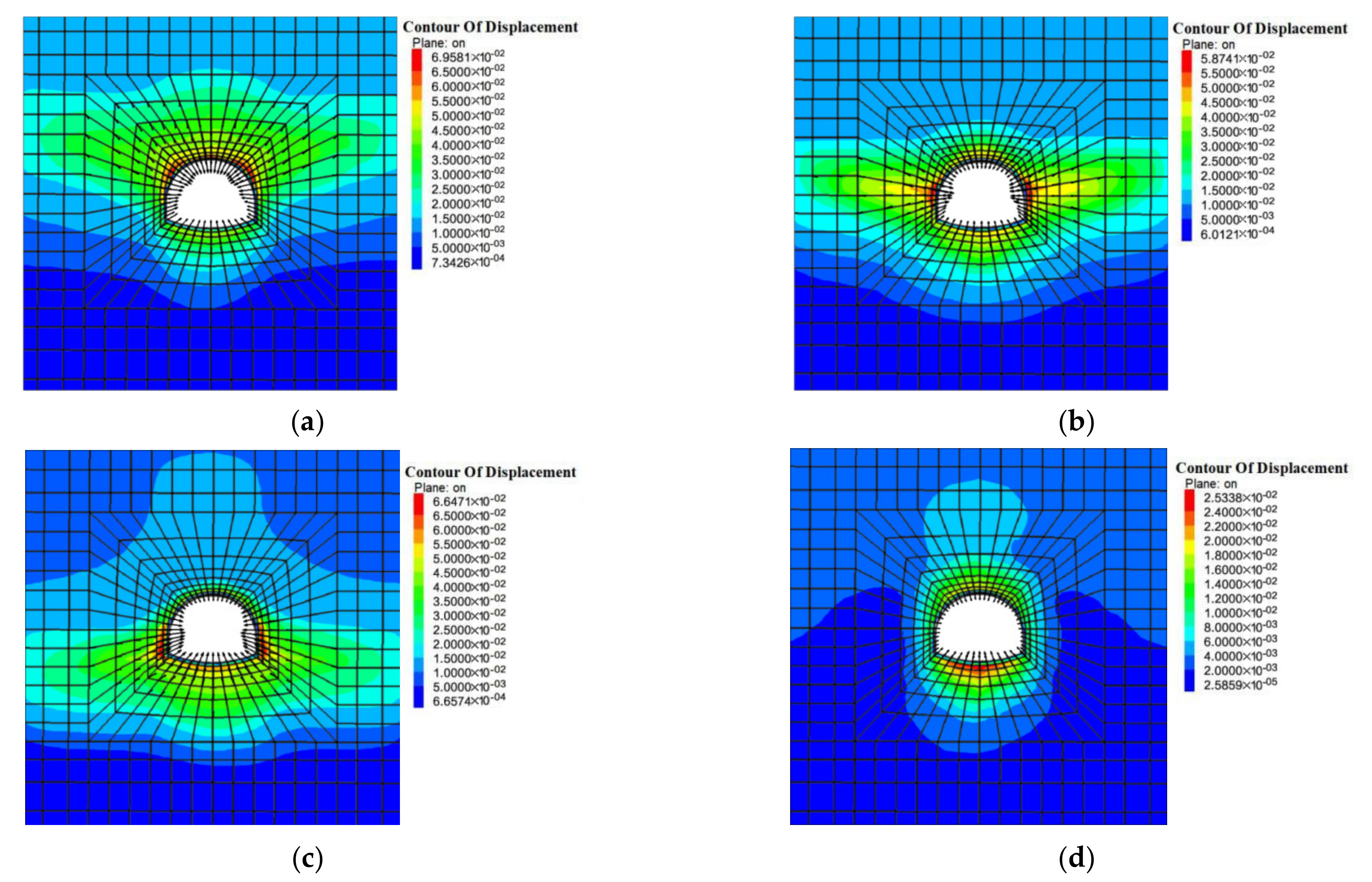
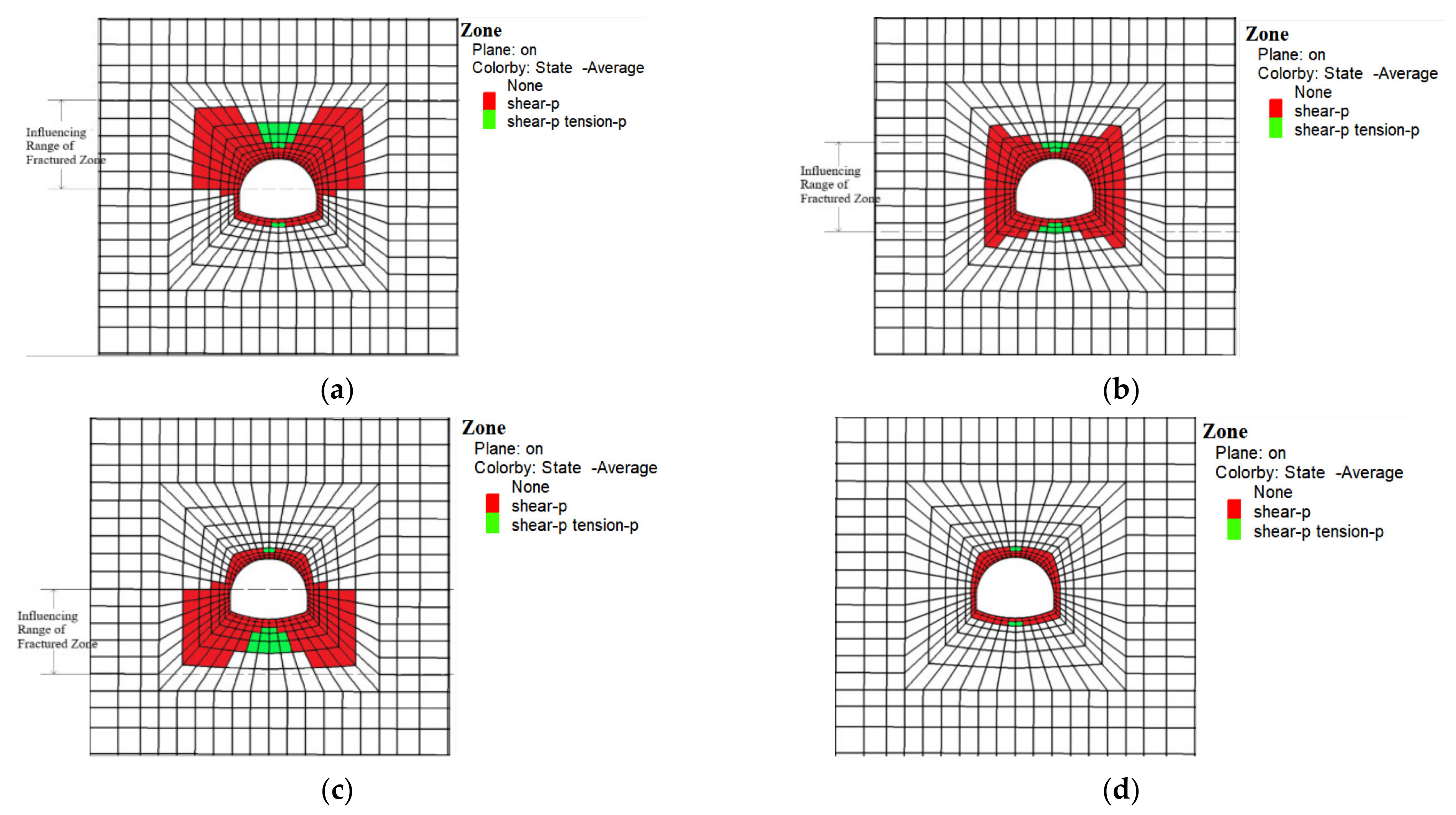
| Surrounding Rock | Young’s Modulus E/GPa | Poisson’s Ratio/μ | Cohesion C/MPa | Friction Φ(o) | Weight γ(kN/m3) | Permeability K/(m/d) |
|---|---|---|---|---|---|---|
| Submarine bedrock | 2.47 | 0.25 | 0.3 | 41.39 | 2600 | 0.007 |
| Fracture zone | 1.21 | 0.35 | 0.13 | 26.25 | 2300 | 0.109 |
| lining | 24.68 | 0.19 | 1.9 | 45.81 | 3100 | 0.56 × 10−6 |
Publisher’s Note: MDPI stays neutral with regard to jurisdictional claims in published maps and institutional affiliations. |
© 2021 by the authors. Licensee MDPI, Basel, Switzerland. This article is an open access article distributed under the terms and conditions of the Creative Commons Attribution (CC BY) license (https://creativecommons.org/licenses/by/4.0/).
Share and Cite
Fang, W.; Wang, G.; Wang, C. Effect of the Location of Fault Fracture Zones on the Stability of Symmetrical Submarine Tunnels. Symmetry 2021, 13, 1111. https://doi.org/10.3390/sym13071111
Fang W, Wang G, Wang C. Effect of the Location of Fault Fracture Zones on the Stability of Symmetrical Submarine Tunnels. Symmetry. 2021; 13(7):1111. https://doi.org/10.3390/sym13071111
Chicago/Turabian StyleFang, Wei, Gang Wang, and Chang Wang. 2021. "Effect of the Location of Fault Fracture Zones on the Stability of Symmetrical Submarine Tunnels" Symmetry 13, no. 7: 1111. https://doi.org/10.3390/sym13071111
APA StyleFang, W., Wang, G., & Wang, C. (2021). Effect of the Location of Fault Fracture Zones on the Stability of Symmetrical Submarine Tunnels. Symmetry, 13(7), 1111. https://doi.org/10.3390/sym13071111





